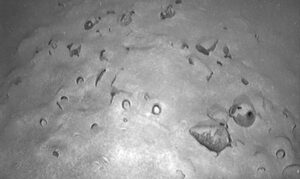Minutes before the U.S. Coast Guard’s news conference about the fate of the missing submersible, OceanGate issued the following statement:
“We now believe that our CEO Stockton Rush, Shahzada Dawood and his son Suleman Dawood, Hamish Harding, and Paul-Henri Nargeolet, have sadly been lost.”
The Titan was a five-person, 10,000kg submersible. It lost contact with its mothership, the MV Polar Prince, on Sunday morning, one hour and 45 minutes into its dive down to the Titanic. The famous ship lies in two pieces 3,800m below on the ocean floor, 600km off the coast of Newfoundland and 1,450km off Cape Cod, Massachusetts.
Since then, an international team has scoured the surface and underwater looking for the submersible and possible survivors.
News conference

Rear Admiral John Mauger addresses reporters. Photo: Screenshot
At the news conference, U.S. Coast Guard Rear Admiral John Mauger confirmed the destruction of the submersible. “The debris is consistent with the catastrophic loss of the pressure chamber,” he explained. “The ROVs will remain on scene and continue to gather information.”
The nine search-and-rescue vessels currently on the scene will begin to demobilize within the next 24 hours, he added.
The debris field that turned out to be the wreckage of the submersible was found 450m from the bow of the Titanic.
Closure
This announcement and its following press conference brings closure to the accident, which has captivated people worldwide.
OceanGate’s announcement continued:
“These men were true explorers who shared a distinct spirit of adventure, and a deep passion for exploring and protecting the world’s oceans. Our hearts are with these five souls and every member of their families during this tragic time. We grieve the loss of life and joy they brought to everyone they knew.
This is an extremely sad time for our dedicated employees who are exhausted and grieving deeply over this loss. The entire OceanGate family is deeply grateful for the countless men and women from multiple organizations of the international community who expedited wide-ranging resources and have worked so very hard on this mission.
We appreciate their commitment to finding these five explorers, and their days and nights of tireless work in support of our crew and their families.
This is a very sad time for the entire explorer community, and for each of the family members of those lost at sea.
We respectfully ask that the privacy of these families be respected during this most painful time.”
Titan Submersible: Timeline and What We Know
Friday, June 16: The expedition leaves St. John’s, Newfoundland, Canada.
Saturday, June 17: A weather window opens up for a dive.
Sunday, June 18: The submersible was supposed to begin its descent at 4 am ET but starts later. Communication with the surface is lost after 1 hour and 45 minutes. The submersible fails to return to the surface as scheduled at 3pm ET.
Monday, June 19: The U.S. Coast Guard receives a report of an overdue submersible from the Titan‘s mothership, the Polar Prince. Search and rescue operations involving U.S. and Canadian ships and planes begin.
Tuesday, June 20: Sounds resembling banging are detected during the day.
Wednesday, June 21: A unified command is established to coordinate the search. More underwater noises are detected, leading to an expanded search area. Additional vessels, including a French research ship, move to join the effort.
Thursday, June 22: The approximate deadline for the submersible’s 96-hour air supply is reached. Remotely operated vehicles are deployed, but it remains uncertain whether the submersible is near the surface or on the seabed. A debris field is discovered near the Titanic wreck. The U.S. Coast Guard holds a press conference confirming that the debris was part of the Titan submersible, including its nose cone.
CBS News later reported that the U.S. Navy had detected “an acoustic anomaly consistent with an implosion” shortly after the Titan lost contact.
This information was relayed to the US Coast Guard, which used it to narrow the radius of its search.
The banging that earlier gave hope that the five aquanauts were still alive is now thought to have been coming from other ships in the area, according to the CBS report.






